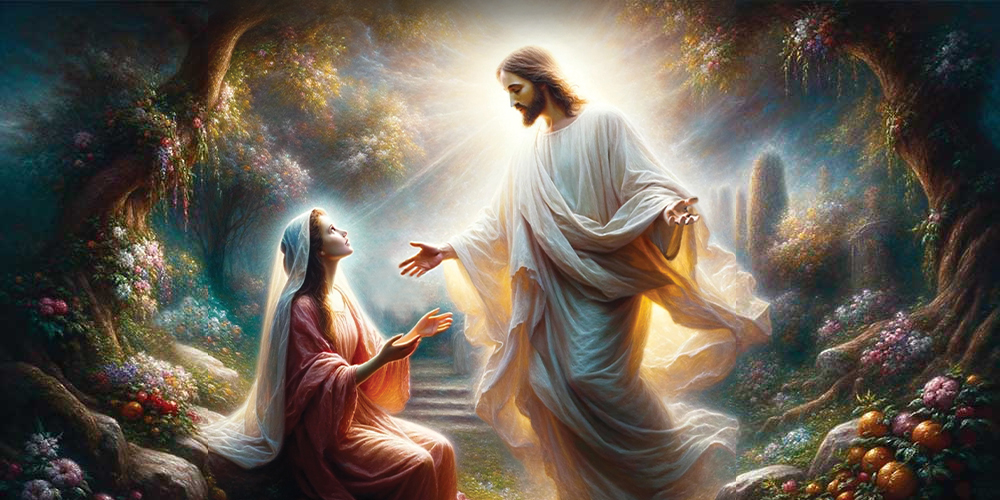 |
Jesus’ appearance to Mary Magdalene in the garden provides hope by showing that the beauty in death for all believers is knowing that death is not the end.
“That’s not him.”
The grass crunched beneath her feet as she walked through the morning dew—or maybe it was saturated with her tears. She didn’t know. She didn’t care. In the cool of the morning, in the heart of Joseph of Arimathea’s garden—really, a glorified personal cemetery—Mary Magdalene was an emotional wreck.
Surprised to see another person as she turned from the tomb, her mind concluded he was merely the caretaker. Her voice responded with, “Tell me where you’ve moved the body.” Her heart broke: “It’s not him.”
Why wasn’t Mary able to recognize her Lord in that moment? Many have been perplexed by how a woman who had faithfully followed and served Jesus for a significant portion of his ministry now wasn’t able to “see” him when he was standing right in front of her. Many explanations have been offered:
- When Mary had last seen Jesus, his body was mutilated on the cross. She wouldn’t be expecting to see a body that was whole and walking around.
- It was early in the morning, still maybe a bit dark out.
- Her weeping eyes and distraught disposition were blurring her vision and her mind.
- The glorified, exalted body of Jesus was a sight she had never seen before.
- Jesus miraculously kept her from recognizing him.
Instead of trying to decipher the why, though, can we just see Mary for who she was? She was a hopeless mess. Her friend was gone. His body was missing. But worst of all, her Savior was dead . . . and along with him, her hope of heaven.
Death brings an ugly end
“That’s not him.”
I remember my sister-in-law’s word of caution before we approached my brother’s casket at his wake: “He’s not going to look like your brother.”
She wasn’t wrong. The man I saw lying there resembled my brother. He had the same skin. The male-pattern baldness he was blessed with—thanks to family genetics—was still there. In every tangible way, that was his body.
But as I stared at his lifeless shell, all I could think was That’s not him. That’s not my brother. The facial features were slightly off. The skin was off-color. He wasn’t sporting that half-cocked smile that everyone knew and loved. And, beyond the physical features, he wasn’t cracking a timely joke and then laughing at it along with everyone else. He wasn’t sharing his limited knowledge on life as if he were some wise, old sage (as older brothers are wont to do). He wasn’t doing what he had loved so much: encouraging others with the message of a Jesus who loves them and lived and died and rose for them.
There wasn’t any of that. It wasn’t him.
That’s what death does. It changes everything. It takes something so beautiful—a life—and brings it to an abrupt, ugly end.
We try to beautify death
Yet, so often, we try to hold on to that beauty, even if only for a few moments more.
We dress Grandpa in his favorite suit, dry-cleaned and pressed for his final fitting. We cram the front of church for the funeral with beautiful floral arrangements bearing kind messages of condolences. We overemphasize the beautiful moments of a life well lived at the intimate gatherings that follow to bring smiles or laughter through the tears. We glamorize the gravesite with flowers and a beautiful headstone to be a lasting remembrance of our loved one.
Even with Mary Magdalene, do you know why she was at Jesus’ tomb in the first place? Luke’s gospel tells us of that Easter morning, how “the women took the spices they had prepared and went to the tomb” (Luke 24:1). According to Jewish custom, wrapping a dead body with spices was a simple, yet dignified ritual that in their minds “allowed the deceased to meet their Maker with the utmost respect and dignity.”*
But, why? Why try to bring beauty to something so ugly?
It’s for us. We do it because we want there to be honor and dignity and beauty in death. We want that to be our lasting memory. But Grandpa’s suit eventually rots. The flowers wilt. If they’re fake, the color fades. The memories do too. And no amount of makeup can mask how quickly death takes over the human body.
There’s nothing beautiful about death. You watch a terminal illness suck the life out of a loved one’s body. The suddenness of a tragic and horrific accident prevents you from saying your good-byes. And, even when loved ones pass peacefully in their sleep or die doing something that they loved, not even that can hide the sad reality: Death—the ugly consequence of the even uglier sin infecting every person—rips people out of this life and away from their loved ones.
Jesus offers true beauty in death
But not that day. Not in that garden.
“Mary!”
One word changed everything. As Pastor Gary Baumler wrote, “Mary’s emotions bounced in a moment from rock bottom to heavenly heights. She not only found Jesus’ body as she wished, she had Jesus alive with her” (The People’s Bible: John, p. 260).
With one word, Mary recognized Jesus. Her Savior lived. Hope was restored. Her eternity was secure.
What’s the word for you? What word from Jesus has changed your life, renewed your hope, and provided beauty even in the midst of the ugliness of sin and death? Here are some of mine:
- At the cross: “Forgive!” “Paradise!” “Finished!”
- Fulfilling Isaiah’s prophecy: “Pierced!” “Crushed!” “Healed!”
- After his resurrection: “Peace!”
- When he made me his child at my baptism and when one day my eyes close and my final breath ends: “Mine!”
What word from Jesus has changed your life, renewed your hope, and provided beauty even in the midst of the ugliness of sin and death?
Every one of those words is a beautiful proclamation of God’s grace and the fulfillment of his incredible promises and his unending love for you and me—made ours through a Savior who lived and died and is no longer dead but lives triumphant from the grave.
That’s not him! At my brother’s committal, as that casket was lowered into his grave, that’s what I thought.
I like how R. C. H. Lenski encapsulates Jesus’ resurrection: “Jesus borrows a tomb” (The Interpretation of St. John’s Gospel, p. 1,330). Lenski quotes Luther, “As he has no grave, for the reason that he will not remain in death and the grave; so we, too, are to be raised up from the grave at the last day through his resurrection and are to live with him in eternity” (The Interpretation of St. John’s Gospel, p. 1,330).
The beauty in death is that it’s not the end. The beauty we try to dignify death with is only temporary. The flowers wither and the body decays, but the joy and perfection of life with Jesus in heaven don’t. The true beauty will be when your earthly life ends, and Jesus welcomes you home as his beautiful, perfect, eternally triumphant saint.
That is him! That’s my brother now!
And because of our resurrected Jesus, that will be you too!
*habad.org/library/article_cdo/aid/367843/jewish/The-Taharah.htm
Author: Jason Strong
Volume 111, Number 04
Issue: April 2024







